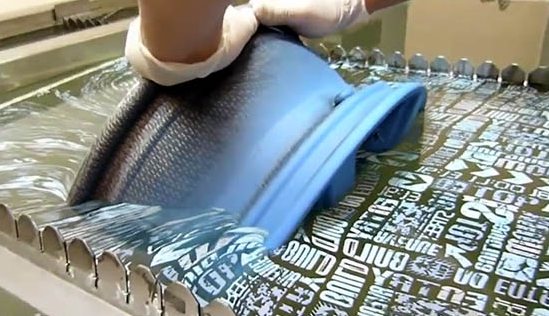Design sure has come a long way from the days of chiseling stone for years to make sculptures. But in some ways, design and liberal art technologies aren’t as advanced as they should be. While we can mass paint cars, that is about all we can do. There was no automated design. That is until Carvo stepped onto the scene.
Carvo focuses on an innovative new painting technology called hydrographic painting. What is hydrographic painting you may ask? According to Wikipedia:
Hydrographic painting is a method of applying printed designs to three-dimensional surfaces using water submersion.
If you haven’t yet seen this in the flesh, here’s a video that goes through the whole process. While it doesn’t look that amazing at the start, the end result is astonishing
It’s fascinating (and slightly addictive) watching the parts disappear into the paint and reemerge as something completely different. As easy as it is to believe that this is all magic, here is the science behind it:
A PVA film with printed colour patterns is placed on top of water. An activator chemical is sprayed on the film to soften the colour film to make it easily stretchable – which is why the pattern looks warped at one point. Next a 3D object is dipped in the water through the film. Once the object touches the film, it stretches around it and sticks. The colouring is transferred onto the object and wa-la!
So if you happen to have a 3D printer, PVA film, activator chemical and gloves lying around in your cupboard, you can make this magic happen. However if you don’t have these, it will cost you. Wheels cost up from $116 and car body panels cost up from $317.
Your tech can also be painted. Gaming controllers cost upwards of $42 and smartphone cases cost upwards of $30. Which isn’t too bad considering you get a completely unique design.
However this technology has it’s limitations. If you have an intricate design, or an intricate object, the film can easily become warped or distorted. You may have noticed the objects in the video used a repetitive design. THat’s for a good reason. Here’s what happens when the film is torn:

You certainly wouldn’t want that on your phone case!
It also is limited in that not everything can be dipped into PVA film and activator chemicals. If you wanted to paint your child’s face, hydrographic painting wouldn’t go too well. For face painting, it’s best to go the traditional way and contact on expert such as Riska Faces.
But as for your phone case? I think it’s time to give it a new paint job.



